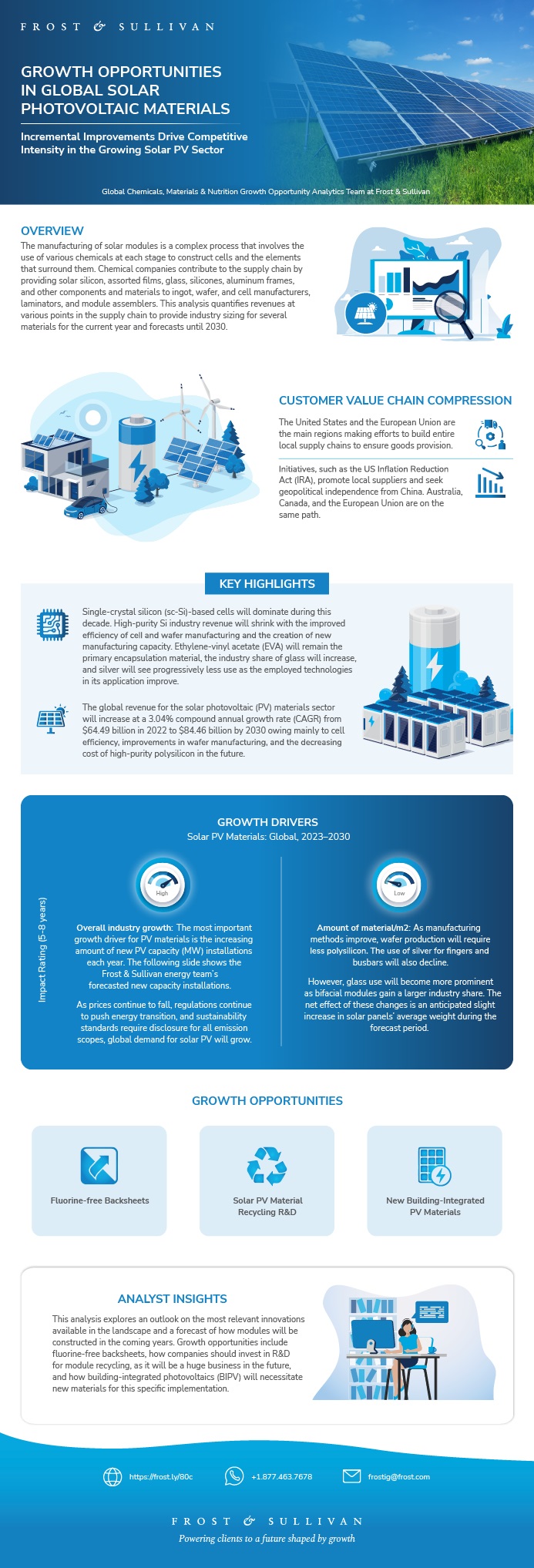Growth Opportunities in Global Solar Photovoltaic Materials
Growth Opportunities in Global Solar Photovoltaic Materials
Incremental Improvements Drive Competitive Intensity in the Growing Solar PV Market
23-Dec-2022
Global
Market Research
$4,950.00
Special Price $4,455.00 save 10 %
Description
The manufacturing of solar modules is a complex process that involves the use of various chemicals at each stage to construct cells and the elements that surround them. Chemical companies contribute to the supply chain by providing solar silicon, assorted films, glass, silicones, aluminum frames, and other components and materials to ingot, wafer, cell manufacturers, laminators, and module assemblers. This report quantifies revenues at various points in the supply chain to provide market sizing for several materials for the current year and forecasts until 2030.
In addition, it offers an outlook on the most relevant innovations available in the market and a forecast of how modules will be constructed in the coming years. Growth opportunities include fluorine-free backsheets, how companies should invest in R&D for module recycling, as it will be a huge business in the future, and how building-integrated photovoltaics (BIPV) will necessitate new materials for this specific implementation.
Author: Leonardo Sampieri
RESEARCH: INFOGRAPHIC
This infographic presents a brief overview of the research, and highlights the key topics discussed in it.Click image to view it in full size

Table of Contents
Why Is It Increasingly Difficult to Grow?
The Strategic Imperative 8™
The Impact of the Top 3 Strategic Imperatives on the Solar PV Materials Industry
Growth Opportunities Fuel the Growth Pipeline Engine
Analysis Highlights
Scope of Analysis
Definitions
Acronyms
Solar Modules, Parts, and Materials
Solar Modules, Parts, and Materials (continued)
Manufacturing Process and Supply Chain
Supply Chain for the Solar PV Materials Market
Considered RMS
Market Shares of Main Solar PV Cell Types (by Primary Active Material)
Forecast Assumptions and Market Sizing Methodology
Forecast Assumptions and Market Sizing Methodology (continued)
Average Module Material Composition and Solar PV Materials That the Report Considers
Growth Metrics
Growth Drivers
Growth Restraints
Downstream Photovoltaic Industry: Global Annual New Power Capacity Additions
Downstream Photovoltaic Industry: 2022–2030 Forecast for Generation Capacity, Units, Surface Area, Weight, and Efficiency in Modules
Downstream Photovoltaic Industry: 2022–2030 Forecast for Mainstream Cell Technologies
Volume of Solar PV Materials, 2022–2030
Revenues of Solar PV Materials, 2022–2030
Volume of Solar PV Materials by Product Type, 2022–2030
Revenues of Solar PV Materials by Product Type, 2022–2030
Impact of Growth Drivers and Restraints on the Solar PV Materials Market
Innovations in Solar PV Cells
Innovative Companies in Solar PV Cells
Innovations in Solar PV Encapsulants
Innovative Companies in Solar PV Encapsulants
Innovations in Solar PV Glass
Innovative Companies in Solar PV Glass
Innovations in Solar PV Backsheets
Innovative Companies in Solar PV Backsheets
Innovations in Solar PV Adhesives
Innovations in Solar PV Adhesives
Innovations in Solar PV Frames
Innovation Companies in Solar PV Frames
Companies in the Solar PV Materials Ecosystem (Not Exhaustive)
Growth Opportunity 1: Fluorine-free Backsheets
Growth Opportunity 1: Fluorine-free Backsheets (continued)
Growth Opportunity 2: Solar PV Material Recycling R&D
Growth Opportunity 2: Solar PV Material Recycling R&D (continued)
Growth Opportunity 3: New Building-Integrated PV Materials
Growth Opportunity 3: New Building-Integrated PV Materials (continued)
Your Next Steps
Why Frost, Why Now?
List of Exhibits
Legal Disclaimer
Popular Topics
| Deliverable Type | Market Research |
|---|---|
| Author | Leonardo Sampieri |
| Industries | Chemicals and Materials |
| No Index | No |
| Is Prebook | No |
| Keyword 1 | Photovoltaic Materials Market |
| Keyword 2 | Solar PV Panels Market |
| Keyword 3 | Solar Photovoltaic Material Market |
| Podcast | No |
| Predecessor | K039-01-00-00-00 |
| WIP Number | K817-01-00-00-00 |
 USD
USD GBP
GBP CNY
CNY EUR
EUR INR
INR JPY
JPY MYR
MYR ZAR
ZAR KRW
KRW THB
THB